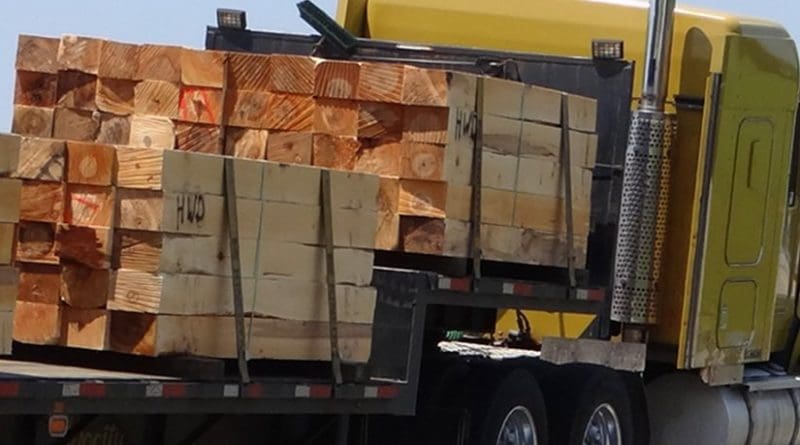US-Canada Softwood Dispute A Possible Own Goal For Washington – Analysis
By Caleb Mills
On June 25, 2017, the United States Department of Commerce announced it would impose a series of tariffs aimed at Canadian soft lumber producers in an attempt to balance the playing field for American companies who are being outpriced with cheap wood from Canada.
The recent escalation of tensions has brought a surprising amount of attention to the trade crisis that has been overlooked throughout the 21st century, especially in the face of bigger commerce issues like Chinese plastic or German carmakers outsourcing American companies. But with the ascension of US businessman Donald Trump to the American presidency in 2017, it seems many of these longstanding economic problems, including this one, will finally face a permanent outcome.
Despite all of the complicated terminology being thrown around in this argument over subsides and government interference in the marketplace, the core issue itself is actually quite simple.
The United States and Canada both use different models for government investment and ownership within their economies, but the relevant difference between the two in this instance is that US lumber is usually owned and harvested by private companies while Canadian lumber is almost always harvested from crown lands; which are owned by the federal and provincial governments.
According to Livingston Trade, 70% of US forests are privately owned while in stark contrast, Canada’s woodlands are 94% owned by the federal and provincial governments. Companies in the US complain that Canadian companies harvest wood from government lands and only have to pay a fee to take the wood, whereas in America private companies invest more money into growing and caring for their crop directly. In their eyes, this means that their cousins across the border gain an unfair advantage due to their ability to access their product cheaper.
Starting back in 1982, the US business community began protesting that through this system where Canadian companies bought wood cheap from the government, Canada was unfairly subsidizing private companies and therefore manipulating prices.
In 2006, Canada and the US finally came to an agreement on the issue called the Softwood Lumber Agreement or SLA. The accord basically stated that the US would end many of their damaging tariffs as long as Canadian lumber was priced at levels that US companies could compete with. Interestingly enough, in an argument over Canada manipulating the market, the US asked Canada to take steps to artificially raise prices to accommodate America – another manipulation of the market.
But the argument did not end there. US businesses have continually complained about Canadian lumber and the challenges it imposes on the American economy. So with President Trump actively on the move to begin raising tariffs, this begs the question: Does Canada’s lumber pose threat to the United States economy in the first place?
Whether or not you believe what the Canadian government and her provinces are doing is a form of subsidization, it is important to note that despite US claims, panels from the World Trade Organization and NAFTA have both found that the Canadian system should not be classified as subsidization. Not only that, but Canada claims to ensure that initial sales of lumber to private companies are set to reflect already existing market tendencies in production.
The lumber industry accounts for 12.5% of Canada’s manufacturing GDP and the United States is its biggest trading partner, which Canada depends on for 52% of her imports. The US also buys 76.7% of Canadian exports, including soft lumber. Meanwhile, Canadian products only account for 13.2% of American imports.
To add perspective, only 21.5% of US imports come from China. Remember the stereotype that everything in America is made in China? Well, if you think that’s true, just remember Canada is almost a third more dependent on the United States for trade than America is on China. Sadly, it seems Canadians might see the label ‘Made in America’ more than actual Americans do.
A full out trade war with America over soft lumber would do tremendous damage to the Canadian economy in the short run, however, it probably wouldn’t take long for other nations to fill in the gap left by the US. Even though America buys the vast majority of Canadian products, recent trade deals with the European Union and the pursuit of new ones with China have already signaled that Prime Minister Justin Trudeau might be taking his nation in a new direction.
On the other hand, a rise in prices due to tariffs would have a more lasting change on the American side, specifically in the housing market. In a report from the US National Association of Home builders, it was found that less access to cheap Canadian lumber could result in a $1,300 increase in costs for a new single-family home. The report also found that in the case of a 25 percent duty imposed on Canadian lumber, the real cost could end up being 8,000 US jobs, and $450 million in wages.
In the end, the real casualties on both sides would be not only businesses but consumers as well, robbed of cheaper prices and a healthier economy as an extension. The effects of a war over lumber actually a present a more startlingly grim outcome than if we were to continue this Cold War standoff over trade. But perhaps the results of such a battle are due to happen with or without such provocation.
As previously mentioned, Canada is increasingly looking towards Europe and Asia for trade, something that was already happening before Donald Trump’s election. In the end, a dispute over lumber would simply accelerate, in a more painful manner, the already existing trend of Canada reaching out for new partners on the global stage.
The opinions, beliefs, and viewpoints expressed by the authors are theirs alone and don’t reflect any official position of Geopoliticalmonitor.com, where this article was published.

